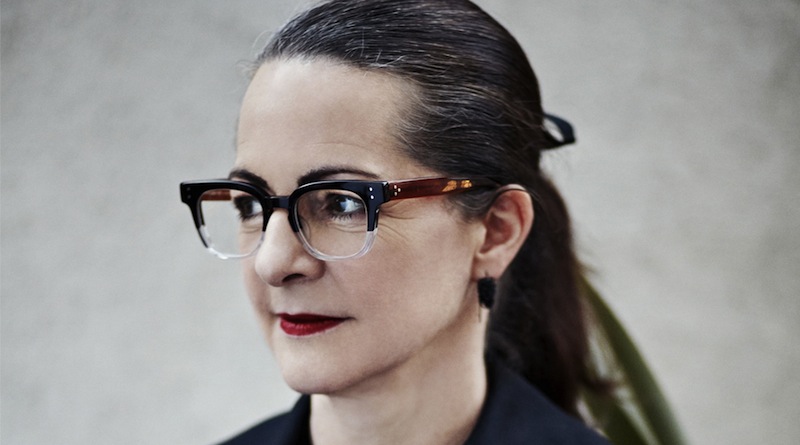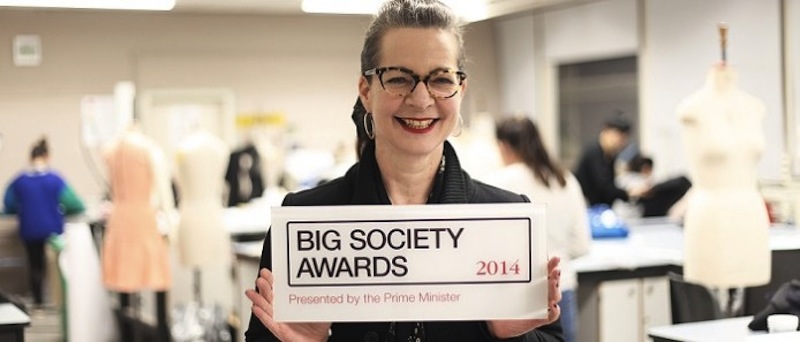fashion study program makeover

Earlier this week SALT Magazine published a story written by Frances Corner, the boss lady of London College of Fashion (LCF). It was good to read words of sustainability coming from a woman of her status. But as usual, I had a few comments. In short, I believe most fashion study programs around the world need a serious green makeover.
“As Head of London College of Fashion, UAL I am often struck by how quickly people dismiss fashion and underestimate its importance to the global economy. However, the fashion industry is worth a staggering £26 billion to the UK economy (Oxford Economics 2014) and globally it has revenues of over $3 billion (2011) which continue to rise.”
We all wear clothes, and the average Finn has about 280 pieces in their wardrobe. The amount of clothes has increased in the past 20 years, but the amount of money we put in them has decreased. It means we buy cheaper stuff. Fashion has a big environmental impact and it is an environmental problem. And it is so big that a few conscious collections, charity fashion shows, organic cotton bags and upcycled t-shirt dresses don´t solve it. Textile industry is the worlds second most polluting industry of fresh water systems (lakes, rivers ect.). But 30% of environmental impact of clothes comes from clothing maintenance, when consumers wash and dry clean them. It is still amazing to me that some people (consumers especially) view fashion industry as something optional or just vanity. This is why it also matters how the schools and study programs are planned and executed. Designers and other fashion professionals can help the consumer to lower their footprints by designing better products and fashion concepts.

“This growth has been facilitated by a business model that focuses on producing an ever-increasing amount of product for an ever decreasing margin, but how long can the fashion industry sustain this sort of model in the face of global climate change?”
The old business model for fashion is indeed outdated and unsustainable. Prices of cotton and other natural fibers are going up year by year as demand increases and the land space for growing them and the water supplies decrease. Due to this, making clothes becomes more expensive every year to the brands and fashion companies. So far the problem has been solved by cutting labour costs, and moving production to cheaper countries with no unions. First to Asia and today to Africa. This has lead to a paradox. The amount of fresh water needed to produce one garment, is 1000 times more than a bottle of drinking water. And the factory worker cannot even afford one water bottle with their salary. Commercial fashion pretty much runs on modern slavery these days.
Oh, and then there is the issue of consuming too much and the ittybitty thing about climate change and the fact that NONE of the fashion companies out there are obligated in any way to recycle their waste (old clothes from consumers, or production waste). Much of fashion focus is on production, when it should be also on the recycle cycle of a garment.
The fact is that we need designers and other fashion professionals trained for sustainable values and processes as a mandatory part of their study programs. It needs to be infused in everything. Some programs are already in play, but they are often optional, or parts of a certain education levels and professional courses.
But when will fashion design schools realize that also teaching to design from POST CONSUMER WASTE (used textiles from consumers, not pre consumer waste or organic materials) is one of the fastest ways to really effect the amount of natural resources used (footprints is negative) and the amount of textile waste prevented in clothing manufacturing? There are still too few of us post consumer waste fashion designers and pattern makers out there. All of the ones I know are self taught and most focus on making unique pieces.
Making clothes from PCW in series is the hardest way of recycle and eco fashion. It is really and art combining form, cutting and mathematics. But it is not impossible, even though many eco fashion professionals say it is not commercially viable. My colleague Paula Malleus has in fact created the first PCW-collection in Finland (maybe the world). Read more about it here and here. Each piece can be sewn in a reasonable time, with minimal seam structures and is sold at reasonable prices. And she could do it again. So don´t tell me it cannot be done. Because she just did. And she would love to teach it to others.

“I know from working with leading fashion brands at London College of Fashion that there is an increasing awareness of ‘our’ part in the problem and what steps need to be taken to ensure the future of our industry, and those millions of people whose livelihoods rely upon it.”
Sustainability, ecology and the ethical issues in fashion are a big umbrella of values. I would love to see in detail what this actually means when it comes to the daily work of a design school. In Finland/Helsinki for example we have Aalto University (School of Arts, Design and Architecture), and they also have sustainability written in to their study programs. Correct me if I´m wrong, but as far as I know, there are not one professor there with a degree in eco fashion or sustainability. I find this a bit odd. Maybe they hire outside lecturers? What is exactly sustainable in the program? I spoke to one eco fashion expert, who has been lecturing there, and it seemed to him as sustainability was not something you´d call must have to the school, but still a nice to have, that just looks good on the curriculum. I´m happy things are different in London. How long before we can hear such a strong public statement from the fashion department of Aalto or the head of the design school?
“The global apparel industry is a significant contributor to greenhouse emissions. The impact of the production of just one T-Shirt is roughly equal to the carbon footprint of driving a car for ten miles. To put this in context, in 2010, the global apparel industry produced more than 150 billion garments, enough to provide more than 20 new articles of clothing to every person on the planet – when dealing with this volume of production it quickly becomes clear how enormous the consequences of our consumption of fashion is for our planet.”
As I mentioned before, fashion business is completely nuts these days. Fresh water is a big issue in the manufacturing process. But basically, if you are not working for a sustainable or an ecological fashion brand today or applying to work for one, weather you were the designer, retail salesperson or wholesale staff, you are part of the problem. If you feel different, I´d love to hear your comments on why you think so. But in order to create all these different jobs in fashion, we need students to be trained in green ways all round. If not, fashion will never change. Design schools have influence on major brands on what type of people they hire and how the school collaborates with fashion companies.
“And it’s not just high emissions which the fashion industry has to tackle, for me one of the most important aspects of climate change is water scarcity. Fashion is a super-consumer of water at almost every stage of its highly complex supply chain, from growing the raw materials, to the dyeing of fabrics, from manufacturing the garments, to transporting them to market. If you consider it takes 2,700 litres of water to produce one cotton t-shirt from ‘crop to shop’ imagine how many swimming pools of water it took to manufacture the contents of your wardrobe – and how many more swimming pools will go into extending its lifespan through regular washes at home. If you combine fashion’s water usage with rising water scarcity and the increasing number of droughts worldwide, access to clean water is only going to become more challenging. In 2007, UN Secretary General Ban Ki-moon described the conflict in Sudan’s Darfur region as the world’s first climate change conflict. The assumption was that water scarcity from changed rainfall patterns resulting from climate change contributed to this conflict. Whether it’s severe flooding in southern England or droughts in Central Africa – water will rapidly become a much fought over commodity that we cannot afford to waste. By 2030 demand for water is estimated to exceed supply by 40 per cent fashion will have no choice but to change.”
You have no idea how happy I am to hear a fashion professional talk about water. These are numbers every fashion professional should know and incorporate to their daily works. I love Frances for reminding both the media and her staff about them.
“I can think of few other industries as creative, innovative and agile as fashion. At LCF I have heavily invested in making sure sustainability is seen less as an adjunct and more an integral part of the process of business and design. We need our graduates to be aware of how influential designers can be in working out ‘cradle to cradle’ solutions before the garment leaves the design board.”
If you want to be in business after 10-15 years, sustainability in fashion is mandatory. It is a must have. If your school does not support it in their study programs, you have to teach yourself. And it is much harder that way..
“It is also important that as one of the world’s leading fashion educators, we work with the industry to ensure we are producing graduates who understand the complexity of the challenges we face – which is why in 2014 we teamed up with global luxury conglomerate Kering, who own some of fashion’s most recognizable brands, such as McQueen and McCartney.”
This sounds interesting. Kering is one of the fashion megacompanies that have 20 high fashion labels on their portfolio. I´d love to see how sustainability fits in their business model.
“Fashion has enormous power to motivate and communicate some complex messages, and historically has produced designers with the ability to shock and draw attention to some of society’s most controversial topics – you just need to look at the work of Katherine Hamnett and Vivienne Westwood to see how galvanizing fashion can be in achieving transformation. For all those people who dismiss fashion as fluff and catwalks, don’t be surprised if the fashion industry rises up and leads the business world in the fight against climate change.”
This is what I have been missing in fashion for a long time. The substance of fashion design. It´s like they say they are training head chefs, and then these people go to work for McDonald´s and serve us fast food. And it saddens me that even after 30 years, Dame Westwood and Katherine Hamnett are still one of the few designers making eco fashion headlines. These women trained themselves in eco fashion. Where is our generation of green designers? I know only a few.
//////////////////////////
Professor Frances Corner OBE is Head of London College of Fashion and Pro Vice-Chancellor of University of the Arts London. She has over 20 years’ experience within the higher education sector at a national and international level. Named a London Leader for Sustainability in 2009, Frances champions the use of fashion as an agent for innovation and change, particularly in the areas of sustainability, health and wellbeing.
Find Frances on Twitter @fcorner





Leave a Reply